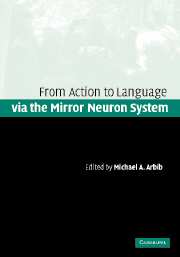Book contents
- Frontmatter
- Contents
- List of contributors
- Preface
- Part I Two perspectives
- Part II Brain, evolution, and comparative analysis
- Part III Dynamic systems in action and language
- 6 Dynamic systems: brain, body, and imitation
- 7 The role of vocal tract gestural action units in understanding the evolution of phonology
- 8 Lending a helping hand to hearing: another motor theory of speech perception
- Part IV From mirror system to syntax and Theory of Mind
- Part V Development of action and language
- Index
- References
7 - The role of vocal tract gestural action units in understanding the evolution of phonology
Published online by Cambridge University Press: 01 September 2009
- Frontmatter
- Contents
- List of contributors
- Preface
- Part I Two perspectives
- Part II Brain, evolution, and comparative analysis
- Part III Dynamic systems in action and language
- 6 Dynamic systems: brain, body, and imitation
- 7 The role of vocal tract gestural action units in understanding the evolution of phonology
- 8 Lending a helping hand to hearing: another motor theory of speech perception
- Part IV From mirror system to syntax and Theory of Mind
- Part V Development of action and language
- Index
- References
Summary
Introduction: duality of patterning
Language can be viewed as a structuring of cognitive units that can be transmitted among individuals for the purpose of communicating information. Cognitive units stand in specific and systematic relationships with one another, and linguists are interested in the characterization of these units and the nature of these relationships. Both can be examined at various levels of granularity. It has long been observed that languages exhibit distinct patterning of units in syntax and in phonology. This distinction, a universal characteristic of language, is termed duality of patterning (Hockett, 1960). Syntax refers to the structuring of words in sequence via hierarchical organization, where words are meaningful units belonging to an infinitely expandable set. But words also are composed of structured cognitive units. Phonology structures a small, closed set of recombinable, non-meaningful units that compose words (or signs, in the case of signed languages). It is precisely the use of a set of non-meaningful arbitrary discrete units that allows word creation to be productive.
In this chapter we outline a proposal that views the evolution of syntax and of phonology as arising from different sources and ultimately converging in a symbiotic relationship. Duality of patterning forms the intellectual basis for this proposal. Grasp and other manual gestures in early hominids are, as Arbib (Chapter 1, this volume) notes, well suited to provide a link from the iconic to the symbolic.
Information
- Type
- Chapter
- Information
- Action to Language via the Mirror Neuron System , pp. 215 - 249Publisher: Cambridge University PressPrint publication year: 2006
References
Accessibility standard: Unknown
Why this information is here
This section outlines the accessibility features of this content - including support for screen readers, full keyboard navigation and high-contrast display options. This may not be relevant for you.Accessibility Information
- 89
- Cited by
